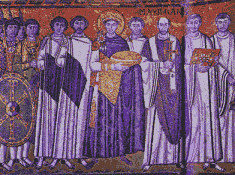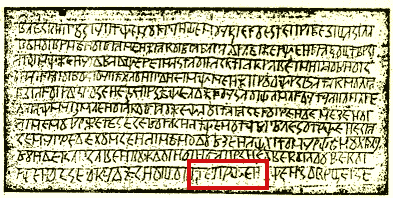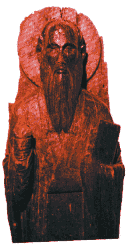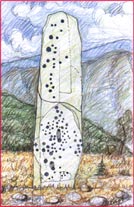UNRESTRAINABLE MACEDONIAN CIVILIZATION
Thanks
to archaeological excavations, archaeological linguistics, and generally
the Ancient Macedonian Linguistics, during the last ten years an absolutely
new chronology on the cultural continuity of the Macedonian people and
oldest life on the Macedonian Peninsula - the Balkans - has been established.
No longer can anyone deny the fact that the skull of the 25 - 30 year-old
young man, discovered in the Crveni Steni cave near the village of Kameni
Gumna (Patralona) in the Aegean pat of Macedonia, is evidence for the
Macedonians that in Macedonia people walked upright and used their head
to think at least 600,000 - 160,000 BC, or which, using a more precise
method, has been confirmed to date from 260,000 - 240,000 BC.
 |
 |
 |
|
The
skull of the 25- 30 year - old young man, discovered in the "Crveni
steni" cave near the village of Kameni Gumna (Petralona) in
the Aegean part of Macedonia (600.000- 160.000 BC)
|
Early
Neolithic seal with solar and cosmography symbolical from Tumba,
village Porodin,
vicinity of Bitola.
|
The
fisherman cabine at the Dojran lake is Macedonian Prehistoric lake
site settlement, which with there own aboriginal architectonic form,
exist at least 8000 - 9000 years.
|
During the last ten years archaeological linguistics has presented a number of written monuments dating from the end of the Mesolithic and beginning of Neolithic period, written in an ancient Macedonian tongue with ancient Macedonian alphabets (“public” and “secret”) which, in written tradition, is witness of the oldest substratum of all following derivative languages and alphabets not only in the Macedonian Peninsula (the Balkans) but throughout the world. The oldest monument to literacy, deciphered to an ancient Macedonian phonetic alphabet and in an ancient Macedonian tongue, dates back to c.13,000 - 11,000 BC, and has a total absolute chronology of continuous Macedonian language of about 15,000 - 13,000 years, and comes from the Mas de Azil cave in France and dates from the time of the conditionally called Great Macedonian Mythological Empire.
![]()
“[‘PEL
VII KOL’[TE“
“SH‘PEL
VII KOL’SHTE“
During the
last ten years archaeological linguistics has presented a number of written
monuments dating from the end of the Mesolithic and beginning of Neolithic
period, written in an ancient Macedonian tongue with ancient Macedonian
alphabets (“public” and “secret”) which, in written
tradition, is witness of the oldest substratum of all following derivative
languages and alphabets not only in the Macedonian Peninsula (the Balkans)
but throughout the world. The oldest monument to literacy, deciphered
to an ancient Macedonian phonetic alphabet and in an ancient Macedonian
tongue, dates back to c.13,000 - 11,000 BC, and has a total absolute chronology
of continuous Macedonian language of about 15,000 - 13,000 years, and
comes from the Mas de Azil cave in France and dates from the time of the
conditionally called Great Macedonian Mythological Empire.
Prehistoric finds
in Osincani, Govrlevo, Mlado Nagoricani, S’pel (Dupjak) Kosturski,
localities of Madgari and Cair in Skopje, the Early Stone Age settlement
at Stenche near Tetovo, localities of the Porodin group near the river
Tsrna, the priceless inscription of the Skocivirska Klisura, the clay
plate from Gradesnitsa near Vratsa (Bulgaria,) the grave-stone monument
of the hero and poet, Dimo Rijdil from BC 7th century from Lemno in the
Aegean Sea, etc. are all only part of the oldest Macedonian civilization
in which there was a dominance of the cult of the Sun and the Cosmos,
the cult of fire and the domestic hearth, the cult of the Great Mother
- goddess of the earth and symbol of fertility, etc.
The ceramic seal from Tserje, in Govrlevo, near Skopje, discovered in
1981, is indisputable evidence that the Macedonian Neolithic revolution
was created by literate, intelligent and most probably rational Macedonian
people, who, during the time of the Macedonian zetovi (sons-in-laws) and
nevesti (brides,) testovi (fathers-in-law,) and teshti (mothers-in-law)
from the end of the Mesolithic and beginning of Neolithic (BC 7,000 -
6,000) were WITH GOD ALONE or remained with GOD only to meditate of the
almighty philosophical aspects of existence and development of man and
humanity, of the almighty semantics in space, of the individual and collective
in cosmos and the world, i.e. of the cult of the Sun and Cosmos, of the
cosmogony and cosmology, of the ‘higher’ and ‘lower’
sciences during the time of the zeti, zetovci, and zetuvanje.
A metal seal from Govrlevo (c.1500 BC) is
evidence of the existence of an appropriate Macedonian military oligarchy.
The oldest remains of architectural individual and grouped volume-spatial
compositions in the form of dwellings constructed on poles reaching above
the surface of the water in the lakes of Kostur, Doiran, Ohrid, Prespa,
and other Macedonian lakes, and the Neolithic continental and island settlements
of Ancient Macedonia all affirm the high level of development of the Macedonian
Civilization. Shrines in the form of Stone Seats (Dolmens) from Tsrna
Loma or Ilina Gora near Osincani, in the vicinity of Skopje, and the complex
of various dolmens from Shterpa, near Bogdantsi, as well as the oldest
Neolithic obelisk from Milisin at the foot of Mt. Kozuf, near Gevgelia,
are irrefutable prehistoric evidence of the continuity and diversification
of the material culture in Macedonia, whose territory was, and will continue
to be for a very long time, attractive for every kind of research and
a means for confirmation, comparison, and expansion of every other world
civilization.
|
|
|
|
Philip II Macedonian (born 382 BC, king 359-336 BC), Alexandar's father |
Alexsandar III Macedonian ( born 356 BC, king 336-323 BC) |
This
kind of Macedonian substratum fully explains the evolutionary process
of Macedonian literacy, language and culture. It enables the explanation
of the level of material and spiritual growth which further enabled -
in historical time - the establishment, maturity and formation - in the
4th Century BC - of the Great Macedonian Empire from the time of Philip
II Macedonian (359 - 336 BC) and Alexander III Macedonian (336 - 323 BC)
which spanned over a territory of 3.8 million km2 from the Danube to North
Africa, and from the Adriatic and Egypt to India and Central Asia, and
possessed exceptional and unquenchable philosophy of syncretism for unification
of the states, peoples, mythologies, gods, customs, and so on. Thus, it
made it possible for this Great Macedonian Civilization- which permanently
enriched itself with new impulses - to spread to the East and the entire
civilized world. This Macedonian cosmopolitanism has been spreading for
at least 2,336 years, with varying intensity independently of the almighty
forms of concealment, usurpation, forgetting, adopting, altering, and
adapting by later civilizations, empires, kingdoms, states, and peoples.
 |
 |
|
St.Vitale
Church, Ravena, mosaic (second quarter of VI century AD) Portrait
of Upravda, Vistinian, Istinian or Justinian I (527- 565 AD) and
his 10 best lawyears.
|
St.Cyril
and St.Metodi, Kamensko, Ohrid, 1864 year
|
Centuries and years that passed have not always been inclined toward affirmation of the Macedonian Civilization. Following Macedonian domination in the world (336 - 30 BC) it was during the period of the second historical Macedonian Empire, so-called Byzantine Empire, that the great Macedonian of Taor - Upravda, Vistinian, Istinian, or Justinian I (527 - 565 BC) succeeded in 529 and 534 to codify the substratum of Macedonian law, which - in the form of Justinian’s Codex having 4,652 decrees, had to find its fertile foundation in the so-called Roman Empire which only finalized the great projects begun in the Ancient Macedonian Civilization. The great historian, writer, and educator, T’rp Ruen (567 BC) is only further evidence of the ability of the Macedonian to return to the roots of his origin, to modify the Macedonian substratum of literacy, and to fertilize the seed of the Macedonian historical memory of the development of literacy and culture of mankind before the great all-Macedonian and all-Slavic educators, St. Cyril, St. Methodius, and St. Clement.
 |
|
|
|
Facsimile on the wooden bar no.15 from the wooden book from 567 A.D. with kept author's name and surname T'rp Ruen |
The Republic
of Macedonia and its expert and scholarly potential must not allow itself
to forget or give up the cultural identity of its people or to change
the NAME which, as MACEDONIANS, we have had at least since the time of
the zet, Pir M’ked’nzki, or continually for at least about 7,000
years.
Ancient linguistics, that of the Middle Ages, and modern Macedonian linguistics
must find its deserved place in every phase of the system of education
in the Republic of Macedonia. Current and future Macedonian researchers
must make efforts to free themselves of the illusions of the 18th, 19th,
and 20th century, i.e. the past. With convincing arguments, they must
incorporate the latest research regarding literacy, language, and culture,
permanently into the continuity of Macedonian civilization, so that they
may find their deserved place in every publication and media in our country
and around the world, therefore, in the third millennium throwing an appropriate
MACEDONIAN LIGHT upon EVERYTHING that is MACEDONIAN in order to illuminate
the oldest canter of civilization - MACEDONIA.
|
PIR
M'KED'NZKI |
 Sculpture with face of St.Clement of Ohrid, XIV century. The church "St.Clement of Ohrid" (Virgin Mary of Perivlepta) |







